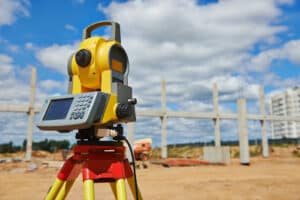As new ALTA Survey requirements are released over time, ensure you are up-to-date with the most recent revisions to enable a quick client process and ensure consistent, legally-conforming properties according to current standards.
The American Land Title Association (ALTA) Survey is the gold standard of land surveys, and a prerequisite for most real estate properties that require title insurance. During an ALTA Survey, a land survey company will log unrecorded information and identify boundary lines, water features, utility connection points, and more.
This process also allows for the location of encroachments, easements, and other areas that may be a future concern to anyone investing in a commercial property. An ALTA Survey can significantly reduce liability for lenders, buyers, and title insurance companies by providing the most in-depth survey of the property.
 However, because ALTA Survey requirements adjust as needed, it is imperative to stay attune to new standards so your clients have the consistent results and data they need to make informed decisions.
However, because ALTA Survey requirements adjust as needed, it is imperative to stay attune to new standards so your clients have the consistent results and data they need to make informed decisions.
The Current Minimum Standard Detail Requirements
The ALTA Survey requirements were most recently released on February 23, 2021, to reflect a new set of revisions. Prior to the 2021 revisions, the standards were amended in 2016 when the formerly-known ALTA/ACSM title was updated to ALTA/NSPS to identify the National Society of Professional Surveyors (NSPS) as the legal successor organization.
Changes to the 2021 ALTA Survey requirements were approved by the ALTA and NSPS boards in October of 2020. The 2021 standards include a selection of minor adjustments for accuracy and clarity, with larger thematic revisions to four major sections. This new theme highlights a greater focus on the in-depth workings of the ALTA Survey, and the role of a surveyor in relation to the survey.
Proof of Underground Utilities
If Table A Option 11 is ticked, a client must prove evidence of underground utilities or coordinate with a utility company to show markings. Similarly, a surveyor must be able to identify a utility owner, or make a notation if that owner is unknown. If a client’s property involves a large plot of land, the cost of the survey may be more significant when this optional element is added.
Removal of Wetland Markers
The prior requirement for surveyors to map wetland delineation markers only if a qualified specialist (hired by a client) has conducted a field delineation has been removed from Table A. This task is not a traditional part of a surveyor’s skillset. However, if a wetlands delineation is an essential portion of a survey, it must be negotiated in Table A Option 20.
Utility Pole Location
According to 2021 amendments, utility poles that are located on or within 10 feet of a property can be used as evidence of easements or burdened property. Surveyors must include the source, or lack thereof, of those utility markings. The standard has also been revised to state that tax parcels are required for unplatted adjoining properties.
Proof of Summary
Surveyors must include a summary of easements and rights of way, as well as other notes about ALTA Survey-related items that benefit, burden, or may not interfere with a property. If, during a survey, a surveyor recognizes a new easement that is not currently logged, it must be shown to a title insurer. A note on the resulting plat map must also be made, describing the information that has been provided to the title insurer. These revisions are outlined in Section 6.C.ii and Section 6.C.viii.
The Reason for ALTA Survey Requirement Revisions
Most of the ALTA Survey revisions center around simple adjustments for clarity. For example, readability often receives a refresh, as well as areas of inconsistency and terms that may be complex or confusing to attorneys, clients, surveyors, or title insurers. However, as real estate legalities change, there can also be amendments and additions to major sections to demonstrate a new process for preparing and conducting an ALTA Survey.
After new standards have been released, a property may need a new survey—even if that property has not undergone any changes since its last survey. If the date of the existing survey is unacceptable, a new survey will be scheduled and the client may be responsible for renegotiating the Optional Table A items. While this can be tedious, this process ensures a property is compliant under the new standards and processes are able to move forward without issue.
Learn More
Visit our website to learn more about the ALTA Survey process and request a quote, or speak directly with a member of the National Due Diligence Services (NDDS) team.
